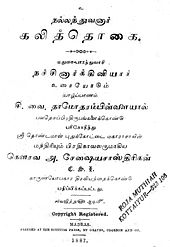CW Damodaram Pillai
CW Damodaram Pillai ( Tamil : சி. வை. தாமோதரம்பிள்ளை Ci. Vai. Tāmōtarampiḷḷai [ ˈd̪aːmoːd̪əɾʌmˌpɨ̯ɭːɛi̯ ], also Thamotharampillai ; born September 12, 1832 in Sirupiddy ; died January 1, 1901 in Madras ) was a Tamil philologist . Born in Ceylon (Sri Lanka), Damodaram Pillai worked most of his life in southern India . He was one of the pioneers of Tamil edition studies who published printed text editions of the classical Tamil texts that had previously only been handed down in manuscript form.
Life
CW Damodaram Pillai was born on September 12, 1832 in the village of Sirupiddy near Jaffna in northern Ceylon. He came from a family of Shivaite Hindus from the Vellala caste . His parents were Vyravanathapillai and Peruntheviyammal. His father introduced him to the study of Tamil at a young age. Later he was tutored by the poet scholar Muttukumara Kavirayar. In addition to the traditional training, he also learned English at the American Mission School of Tellippalai . From 1844 to 1852 he attended the seminary in Batticotta (Vaddukoddai), also run by American missionaries , where he received Western training. After graduating, he worked briefly as a teacher.
In 1853 the British missionary Peter Percival , who had previously worked in Jaffna, brought Damodaram Pillai to Madras (Chennai) in southern India to work as editor for Percival's Tamil-language newspaper Dinavartamani . A little later, Damodaram Pillai was appointed as a Tamil lecturer at the Presidency College . After the University of Madras emerged from the Presidency College in 1857 , Damodaram Pillai took a Bachelor of Arts examination there in 1858 . This made him the first graduate of the university. After graduating, he worked briefly as a teacher in Calicut (Kozhikode), but was then accepted into the civil service as an auditor in Madras. In 1871 he completed a law degree with a Bachelor of Laws . Damodaram Pillai later moved to Kumbakonam and practiced as a lawyer there . In 1887 he was appointed judge in Pudukkottai . After his retirement in 1890, he returned to Madras, where he continued to work as a lecturer and examiner for the University of Madras. In 1895 the British colonial government awarded him the prestigious title Rao Bahadur . On January 1, 1901, CW Damodaram Pillai died in Madras at the age of 68.
plant
CW Damodaram Pillai was one of the pioneers of Tamil philology, who in the 19th and early 20th centuries edited the texts of classical Tamil literature that had previously only been handed down in the form of palm leaf manuscripts and published them as printed text editions. Alongside his younger contemporary UV Swaminatha Iyer (1855–1942), Damodaram Pillai is one of the most famous of the editors.
Damodaram Pillai's editing activities mainly included grammatical works. He published the three parts of the Tolkappiyam , the oldest Tamil grammar work, with various commentaries , as well as three other grammar works ( Virasoliyam , Iraiyanar Agapporul and Ilakkana Vilakkam ). Damodaram Pillai also played an important role in the rediscovery of Sangam literature , the oldest layer of Tamil poetry. His edition of Kalittogai , published in 1887, was the first printed edition of a Sangam text (with the exception of Tirumurugatruppadai , which had a special status because of its religious content). The printing of the hitherto largely forgotten Sangam texts triggered the so-called Tamil Renaissance and played a significant role in the strengthening of Tamil cultural awareness.
Text editions published by CW Damodaram Pillai:
- Nidinerivilakkam (1853)
- Tolkappiyam Solladigaram with Commentary by Senavaraiyar (1868)
- Virasoliyam (1881)
- Iraiyanar Agapporul (1883)
- Tanigaippuranam (1883)
- Tolkappiyam Poruladigaram with the commentaries of Nachinarkkiniyar and Perasiriyar (1885)
- Kalittogai (1887)
- Ilakkana Vilakkam (1889)
- Sulamani (1889)
- Tolkappiyam Eluttadigaram with commentary by Nachinarkkiniyar (1891)
- Tolkappiyam Solladigaram with commentary by Nachinarkkiniyar (1892)
literature
- V. Muttucumaraswamy: CW Thamotharampillai. Jaffna: Uma Siva Pathipakam, 1971.
- Kamil Zvelebil: Companion Studies to the History of Tamil Literature. Leiden, New York, Kobenhavn, Cologne: EJ Brill, 1992. pp. 174-177.
| personal data | |
|---|---|
| SURNAME | Damodaram Pillai, CW |
| ALTERNATIVE NAMES | Damodarampillai, CW; Thamotharam Pillai, CW; Thamotharampillai, CW; Damodaram Pillai, SV; Damodarampillai, SV; Thamotharam Pillai, SV; Thamotharampillai, SV; Tāmōtarampiḷḷai, Ci. Vai .; Tāmōtaram Piḷḷai, Ci. Vai .; தாமோதரம்பிள்ளை, சி. வை. (Tamil); தாமோதரம்பிள்ளை, சி. வை. (Tamil); தாமோதரம் பிள்ளை, சி. வை. (tamil) |
| BRIEF DESCRIPTION | Tamil philologist |
| DATE OF BIRTH | September 12, 1832 |
| PLACE OF BIRTH | Syrupiddy |
| DATE OF DEATH | January 1, 1901 |
| Place of death | Madras |

